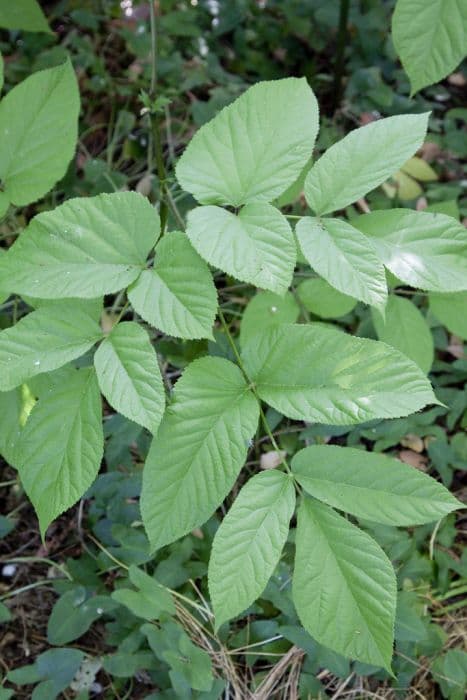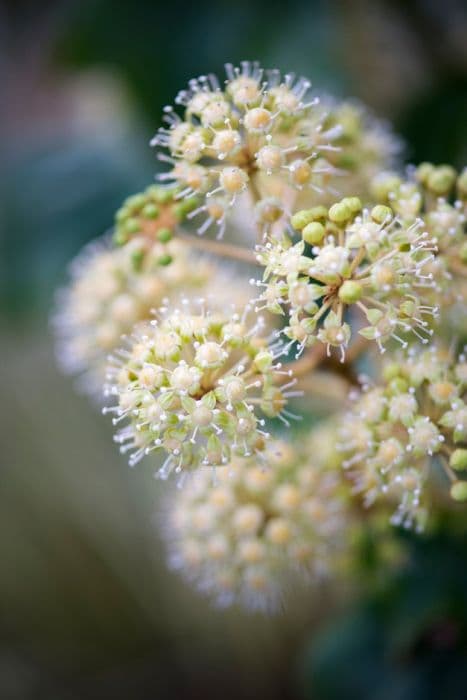Japanese angelica tree Aralia elata 'Variegata' (v)

ABOUT
Aralia elata 'Variegata', also known as Japanese angelica tree, is a striking ornamental plant celebrated for its distinct foliage and architectural form. Its main feature is its leaves, which are large and compound, with multiple leaflets arranged on each leaf stem. The leaflets of the 'Variegata' variety are particularly attractive due to their variegated pattern—irregular edges of creamy white and shades of green. This variegation adds a bright splash of color and can be a standout feature in any garden space. The leaves emerge in spring, showcasing their variegation as they unfurl. As the plant grows, the leaves can create a lush, tropical-like canopy, giving it an exotic appearance. The Japanese angelica tree also blooms in late summer, producing clusters of small, white flowers that can add a touch of elegance to the plant. These flowers can attract pollinators and are usually followed by small, dark-colored fruits that provide further interest in the landscape. Stem and bark characteristics of this plant include woody stems with some rugged texture, which adds to its ornamental appeal. The bark may be lightly colored and can develop an aged appearance over time, contributing to the plant's overall aesthetic. The Japanese angelica tree combines its leaf, flower, fruit, stem, and bark qualities to present a well-rounded, visually captivating specimen in non-winter months.
About this plant
 Names
NamesFamily
Araliaceae
Synonyms
Japanese Angelica Tree, Variegated Angelica Tree, Variegated Aralia
Common names
Aralia elata 'Variegata'
 Toxicity
ToxicityTo humans
The plant commonly known as Japanese angelica tree has components that may cause irritation or an allergic reaction if handled or ingested. While consuming parts of the Japanese angelica tree isn’t typically fatal, ingestion can lead to discomfort or symptoms such as nausea, vomiting, diarrhea, and stomach cramps. It is always prudent to avoid eating parts of ornamental plants due to potential toxicity.
To pets
The Japanese angelica tree may present similar risks to pets as it does to humans. If pets ingest parts of this plant, they may experience gastrointestinal upset, which can manifest as drooling, vomiting, diarrhea, or abdominal pain. As with humans, it is best to prevent pets from chewing on or consuming parts of ornamental plants like the Japanese angelica tree to avoid the possibility of poisoning.
 Characteristics
CharacteristicsLife cycle
Perennials
Foliage type
Deciduous
Color of leaves
Variegated
Flower color
White
Height
6-8 feet (1.8-2.4 meters)
Spread
6-8 feet (1.8-2.4 meters)
Plant type
Shrub
Hardiness zones
4
Native area
Asia
Benefits
 General Benefits
General Benefits- Ornamental Appeal: The 'Variegata' variety of Japanese angelica tree provides visual interest with its variegated foliage that can brighten garden spaces.
- Landscape Variety: The tree's unique leaf patterning adds diversity to the overall texture and color scheme of any garden or landscape design.
- Habitat for Wildlife: Like many trees, it can provide shelter and food for birds and other wildlife, contributing to local biodiversity.
- Seasonal Interest: This plant offers seasonal changes in appearance, including flowers in spring and sometimes fall color, adding to the year-round interest in a garden.
- Tolerance of Conditions: It is known for its general hardiness and ability to tolerate a range of soil conditions, which makes it a versatile choice for many gardeners.
 Medical Properties
Medical PropertiesThis plant is not used for medical purposes.
 Air-purifying Qualities
Air-purifying QualitiesThis plant is not specifically known for air purifying qualities.
 Other Uses
Other Uses- Aralia elata 'Variegata' can be used in floral arrangements, particularly because of its variegated foliage which adds a unique texture and color contrast to bouquets or indoor displays.
- The plant's wood is sometimes utilized in the creation of small wooden crafts due to its fine grain and ease of carving.
- In landscaping, this plant is often used as a focal point because of its striking appearance and ability to draw the eye in garden designs.
- The variegated leaves can be used as a natural dye source, providing subtle color variations for textiles or paper.
- The plant can be incorporated into education about variegation and genetics in plant biology classes to illustrate natural variation.
- Photographers and artists may use Aralia elata 'Variegata' as a subject for practicing texture and pattern depiction in their works.
- Leaves and stems can be used in the art of plant pressing, contributing to herbarium collections or as part of decorative art pieces.
- In permaculture, this plant might be included for its aesthetic value and to support local biodiversity by providing habitat for insects and birds.
- The plant can be used in hedges or privacy screens where its dense foliage can create a natural, albeit non-traditional, barrier.
- As a winter interest plant, Aralia elata 'Variegata' can be used to maintain visual appeal in gardens during the dormant season with its structural form.
Interesting Facts
 Feng Shui
Feng ShuiThe Japanese Angelica Tree is not used in Feng Shui practice.
 Zodiac Sign Compitability
Zodiac Sign CompitabilityThe Japanese Angelica Tree is not used in astrology practice.
 Plant Symbolism
Plant Symbolism- Resilience - The Aralia elata 'Variegata', commonly known as the Japanese angelica tree, is known for its ability to thrive in tough growing conditions, symbolizing the ability to persist and adapt through challenging times.
- Protection - With its spiny stems and sturdy structure, the Japanese angelica tree represents safeguarding and defense against negative forces.
- Regal Presence - Its grand stature and decorative foliage signify a commanding presence and a sense of royalty or respectability.
- Elegance - The variegated leaves of Aralia elata 'Variegata' add an element of visual sophistication, representing grace and refinement in the plant world.
 Water
WaterThe Japanese aralia, or Aralia elata 'Variegata', should be watered once the top inch of soil feels dry to the touch. This may translate to watering approximately every 7 to 10 days, depending on environmental conditions. When watering, use room temperature water to thoroughly soak the soil until excess water drains from the bottom of the pot. Between 16 to 32 ounces of water each time is suitable for a medium-sized pot, adjusting for the size of the plant and container. During the winter months, water less frequently to match the plant's reduced growth and transpiration rates.
 Light
LightJapanese aralia thrives in bright, indirect light conditions such as a north-facing or east-facing window provides. Direct sunlight, especially during the harsh afternoon hours, should be avoided as it can scorch the leaves. A spot with dappled sunlight, as typically found under the canopy of larger trees when planted outdoors, is ideal.
 Temperature
TemperatureFor the Japanese aralia, the ideal temperature range is between 60 and 80 degrees Fahrenheit. It will not tolerate temperatures below 50 degrees Fahrenheit, as it is prone to cold damage. The plant prefers consistent temperatures and should be protected from drafts and sudden temperature changes.
 Pruning
PruningPrune the Japanese aralia to maintain its shape and size, and to remove dead or damaged leaves. The best time for pruning is in the late winter or early spring before new growth begins. Pruning can be done annually or as needed to keep the plant looking tidy and to encourage a fuller growth habit.
 Cleaning
CleaningAs needed
 Soil
SoilJapanese Angelica Tree prefers well-draining soil with a mix of loam, peat, and sand for aeration; a pH of 6.0-7.5 is ideal to promote healthy growth.
 Repotting
RepottingJapanese Angelica Tree should be repotted every 2-3 years or when roots become crowded to encourage continued health and growth.
 Humidity & Misting
Humidity & MistingJapanese Angelica Tree thrives at moderate humidity levels, around 40-60%, for optimal leaf health without additional watering requirements.
 Suitable locations
Suitable locationsIndoor
Ensure bright light, moderate humidity, and regular watering.
Outdoor
Plant in well-draining soil, partial sun, and protect from harsh winds.
Hardiness zone
4-9 USDA.
 Life cycle
Life cycleAralia elata 'Variegata', commonly known as the variegated Japanese angelica tree, begins its life cycle as a seed, which, under favorable conditions of warmth and moisture, germinates to produce a small seedling. The seedling develops into a juvenile plant by establishing a root system and a shoot that grows upwards with foliar variegation that is characteristic of this cultivar. As the plant matures, it enters the vegetative growth stage, expanding its canopy with large, bi- or tri-pinnate leaves edged with white or yellow variegation, while the trunk and structure strengthen. This deciduous shrub or small tree goes through an annual cycle of leafing out in the spring, growing through the summer, and then losing its leaves in the fall. After several years, it reaches reproductive maturity and during late summer and early fall, it produces large panicles of tiny white flowers that are attractive to pollinators. Once pollinated, these flowers develop into small black fruit that mature and disperse seeds, completing the life cycle and starting the process anew.
 Propogation
PropogationPropogation time
Spring-Early Summer
The most popular method of propagating the Japanese Angelica Tree involves taking softwood cuttings in late spring or early summer when new growth is still tender and green. To begin, select a healthy branch and cut a 4 to 6-inch (10 to 15 cm) section just below a leaf node, ensuring there are several leaves on the cutting. Remove the lower leaves to expose a clear stem, which will be inserted into the growing medium. It's beneficial to dip the cut end in rooting hormone before planting to encourage root development. The cutting should then be placed in a pot filled with a well-draining soil mix and kept moist but not waterlogged, ideally under a plastic cover or in a humid environment to retain moisture. New roots typically form within a few weeks, after which the cutting can gradually acclimate to less humid conditions before being transplanted outdoors.









